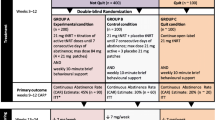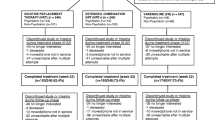Abstract
Rationale
Decreasing withdrawal and craving during smoking cessation is a major aim of cessation medications. Prior studies have shown that Nicotine Replacement Therapy (NRT) decreases withdrawal symptom severity but have relied on retrospective reports and lacked robust measures of baseline symptoms or symptoms during unmedicated abstinence.
Objectives and methods
We tested the effect of high-dose (35 mg) nicotine patch on withdrawal and craving during abstinence using real-time assessment with electronic diaries during ad libitum smoking, a brief period of experimentally directed trial abstinence, and the first 3 days of cessation. Subjects were 324 smokers randomized to high-dose nicotine patches or placebo.
Results
Treatment with active patches reduced withdrawal and craving during cessation and completely eliminated deprivation-related changes in affect or concentration.
Conclusion
High-dose NRT reduces withdrawal symptoms and craving and can eliminate some symptoms entirely.


Similar content being viewed by others
References
American Psychiatric Association (1994) Diagnostic and statistical manual of mental disorders, 4th edn. Author, Washington, DC
Cosby RH, Howard M, Kaczorowski K, Willan A, Sellors JW (2003) Randomizing patients by family practice: sample size estimation, intracluster correlation and data analysis. Fam Pract 20:77–82
Dale LC, Hurt RD, Offord KP, Lawson GM, Croghan IT, Schroeder DR (1995) High-dose nicotine patch therapy: percentage of replacement and smoking cessation. JAMA 274:1353–1358
Dols M, van den Hout M, Kindt M, Willems B (2002) The urge to smoke depends on the expectation of smoking. Addiction 97:87–93
Hammersley R (1994) A digest of memory phenomena for addiction research. Addiction 89:283–293
Heatherton TF, Kozlowski LT, Frecker RC, Fagerstrom KO (1986) The Fagerstrom Test for Nicotine Dependence: a revision of the Fagerstrom Tolerance Questionnaire. Br J Addict 86:1119–1127
Henningfield J (1995) Nicotine medications for smoking cessation. N Engl J Med 333:1196–1203
Hufford MR, Shields AL, Shiffman S, Paty J, Balabanis M (2002) Reactivity to ecological momentary assessment: an example using undergraduate problem drinkers. Psychol Addict Behav 16:205–211
Hughes JR, Hatsukami D (1986) Signs and symptoms of tobacco withdrawal. Arch Gen Psychiatry 43:289–294
Hughes JR, Gust SW, Keenan RM, Fenwick JW, Healey ML (1989) Nicotine vs. placebo gum in general medical practice. JAMA 261:1300–1305
Hughes JR, Higgins ST, Hatsukami DK (1990) Effects of abstinence from tobacco: a critical review. In: Kozlowski LT et al (eds) Research advances in alcohol and drug problems. Plenum, New York, pp 317–398
Jarvik M, Henningfield J (1993) Pharmacological adjuncts for the treatment of tobacco dependence. In: Nicotine addictions: principles and management. Oxford University Press, London, pp 245–261
Killen JD, Fortmann SP (1997) Craving is associated with smoking relapse: findings from three prospective studies. Exp Clin Psychopharmacol 5:137–142
Killen JD, Fortmann SP, Davis L, Strausberg L, Varady A (1999) Do heavy smokers benefit from higher dose nicotine patch therapy? Exp Clin Psychopharmacol 7:226–233
Maude-Griffin PM, Tiffany ST (1996) Production of smoking urges through imagery: the impact of affect and smoking abstinence. Exp Clin Psychopharmacol 4:198–208
Niaura R, Sayette M, Shiffman S et al (in press) Comparative efficacy of rapid-release nicotine gum versus nicotine polacrilex gum in relieving smoking cue-provoked craving. Addiction
Patten CA, Martin JE (1996) Does nicotine withdrawal affect smoking cessation? Clinical and theoretical issues. Ann Behav Med 18:190–200
Payne TJ, Smith PO, Sturges LV, Holleran SA (1996) Reactivity to smoking cues: mediating roles of nicotine dependence and duration of deprivation. Addict Behav 21:139–154
Piasecki TM, Niaura R, Shadel WG, Abrams D, Goldstein M, Fiore MC, Baker TB (2000) Smoking withdrawal dynamics in unaided quitters. J Abnorm Psychol 109:74–86
Redelmeier D, Kahneman D (1996) Patients' memories of pain medical treatments: real-time and retrospective evaluations of two minimally invasive procedures. Pain 66:3–8
Rose JE, Herskovic JE, Trilling Y, Jarvik ME (1985) Transdermal nicotine reduces cigarette craving and nicotine preference. Clin Pharmacol Ther 38:450–456
Ross HD, Chan KK, Piraino AJ, John VA (1991) Pharmacokinetics of multiple daily transdermal doses of nicotine in healthy smokers. Pharm Res 8:385–388
Russell J (1980) A circumplex model of affect. J Pers Soc Psychol 37:345–356
Sayette MA, Wert JM, Martin CS, Cohn JF, Perrott MA, Hobel J (2003) Effects of smoking opportunity on cue-elicited urge: a facial coding analysis. Exp Clin Psychopharmacol 11:218–227
Shiffman S, Jarvik ME (1976) Smoking withdrawal symptoms in two weeks of abstinence. Psychopharmacology (Berl) 50:35–39
Shiffman S, Read L, Maltese J, Rapkin D, Jarvik ME (1985) Preventing relapse in exsmokers. In: Marlatt GA, Gordon JR (eds) Relapse prevention: maintenance strategies in the treatment of addictive behaviors. Guilford Press, New York, pp 472–520
Shiffman S, Paty JA, Gnys M, Kassel JD, Hickcox M (1996). First lapses to smoking: within subjects analysis of real time reports. J Consult Clin Psychol 64:366–379
Shiffman S, Engberg J, Paty JA, Perz W, Gnys M, Kassel JD, Hickcox M (1997a) A day at a time: predicting smoking lapse from daily urge. J Abnorm Psychol 106:104–116
Shiffman S, Hufford M, Hickcox M, Paty JA, Gnys M, Kassel JD (1997b) Remember that? A comparison of real-time versus retrospective recall of smoking lapses. J Consult Clin Psychol 65:292–300
Shiffman S, Balabanis MH, Paty JA, Engberg J, Gwaltney CJ, Liu K, Gnys M, Hickcox M, Paton SM (2000a) Dynamic effects of self-efficacy on smoking lapse and relapse. Health Psychol 19:315–323
Shiffman S, Elash CA, Paton SM, Gwaltney CJ, Paty JA, Clark DB, Liu KS, DiMarino ME (2000b) Comparative efficacy of 24-hour and 16-hour transdermal nicotine patches for relief of morning craving. Addiction 95:1185–1195
Shiffman S, Gwaltney CJ, Balabanis MH, Liu KS, Paty JA, Kassel JD, Hickcox M, Gnys M (2002) Immediate antecedents of cigarette smoking: an analysis from ecological momentary assessment. J Abnorm Psychol 111:531–545
Shiffman S, Scharf D, Shadel W, Gwaltney C, Dang Q, Paton S, Clark D (in press) Analyzing milestones in smoking cessation: an illustration from a randomized trial of high dose nicotine patch. J Consult Clin Psychol
Stone AA, Shiffman S (1994) Ecological momentary assessment (EMA) in behavioral medicine. Ann Behav Med 16:199–202
Stone AA, Shiffman S, Schwartz JE, Broderick JE, Hufford MR (2002) Patient non-compliance with paper diaries. BMJ 324:1193–1194
Stone AA, Broderick JE, Schwartz JE, Shiffman S, Litcher-Kelly L, Calvanese P (2003) Intensive momentary reporting of pain with an electronic diary: reactivity, compliance, and patient satisfaction. Pain 104:343–351
Swan GE, Ward MA, Jack LM (1996) Abstinence effects as predictors of 28-day relapse in smokers. Addict Behav 21:481–490
Teasdale JD, Fogarty SJ (1979) Differential effects of induced mood on retrieval of pleasant and unpleasant events from episodic memory. J Abnorm Psychol 88:248–257
Teneggi V, Tiffany ST, Squassante L, Milleri S, Ziviani L, Bye A (2002) Smokers deprived of cigarettes for 72 h: effect of nicotine patches on craving and withdrawal. Psychopharmacology (Berl) 164:177–187
Tiffany ST, Cox LS, Elash CA (2000) Effects of transdermal nicotine patches on abstinence-induced and cue-elicited craving in cigarette smokers. J Consult Clin Psychol 68:233–240
Transdermal Nicotine Study Group (1991) Transdermal nicotine for smoking cessation: six-month results from two multicenter controlled clinical trials. JAMA 266:3133–3138
Waters AJ, Shiffman S, Sayette MA, Paty JA, Gwaltney CJ, Balabanis MH (2004) Cue provoked craving and nicotine replacement therapy in smoking cessation. J Consult Clin Psychol 72:1136–1143
West RJ, Hajek P, Belcher M (1989) Severity of withdrawal symptoms as a predictor of outcome of an attempt to quit smoking. Psychol Med 19:981–985
Zeger SL, Liang K, Albert PS (1988) Models for longitudinal data: a generalized estimating equation approach. Biometrics 44:1049–1060
Acknowledgements
This research was supported by Grant DA 06084 from the National Institute on Drug Abuse to Saul Shiffman. We are grateful to GlaxoSmithKline Consumer Healthcare (GSKCH) for providing nicotine and placebo patches for the study; GSKCH did not otherwise participate in the study or the paper. The authors acknowledge the assistance of Stephanie Paton and Celeste Elash in conducting this study; and Yolanda DiBucci and Qianyu Dang in manuscript preparation
Author information
Authors and Affiliations
Corresponding author
Additional information
Saul Shiffman and Stuart Ferguson consult exclusively for GlaxoSmithKline Consumer Healthcare on matters relating to existing smoking cessation products. Dr. Shiffman also has an interest in a new smoking cessation product, and is a founder of invivodata, inc., which provides electronic diaries for clinical trials.
Rights and permissions
About this article
Cite this article
Shiffman, S., Ferguson, S.G., Gwaltney, C.J. et al. Reduction of abstinence-induced withdrawal and craving using high-dose nicotine replacement therapy. Psychopharmacology 184, 637–644 (2006). https://doi.org/10.1007/s00213-005-0184-3
Received:
Accepted:
Published:
Issue Date:
DOI: https://doi.org/10.1007/s00213-005-0184-3




